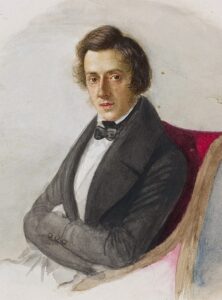Chopin, Nocturne in B Major, Op. 9 No. 3

Last week we featured a nocturne by John Field, who is credited as the inventor or originator of the genre. Field had considered other potential labels for his emotional and highly expressive style of writing, but settled on “nocturne” when he published his first nocturne in 1812.
A generation later, Frédéric Chopin (1810-1849) would write 19 nocturnes (18 published during his lifetime), expanding the form, and securing his place as the pre-eminent composer of the genre. Some publishers have assigned the label of nocturne to two additional pieces not published during Chopin’s lifetime. You might say that what J. S. Bach is the fugue, Chopin is to the nocturne.
Chopin was a great admirer of Field and was clearly influenced by him. Field, on the other hand, thought little of Chopin’s nocturnes and once described Chopin as a “sickroom talent.”
Perhaps Chopin’s greatest contribution can be found in his long, flowing melodies, influenced by the bel canto arias of his friend Vincenzo Bellini. Chopin’s melodies, like the bel canto style, have a singable quality along with an emphasis on ornamentation and dramatic expression. While the melody seems improvisatory, it is all carefully planned. Chopin draws a rhythmic distinction between the free-flowing rhythm of the melody and the broken chord accompaniment. While the accompaniment follows a consistent 6/8 pattern of eighth notes (in pairs of 3 beats), the melody often pits figures of 4 or 5 (or even 8 or 14) notes evenly spaced against the 3 notes in the accompaniment, so that the melody follows its own rhythmic path and is not constrained by the accompaniment.
And while Field tended to stay in the realm of introspection throughout his nocturnes, Chopin injected moments of high energy and virtuosity. His nocturnes tend to have a distinct, contrasting middle section—often a high-energy section perhaps marked as agitato (as in this one) or con fuoco.



